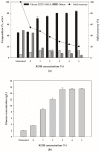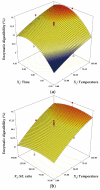Improvement of Enzymatic Glucose Conversion from Chestnut Shells through Optimization of KOH Pretreatment
- PMID: 33916606
- PMCID: PMC8038493
- DOI: 10.3390/ijerph18073772
Improvement of Enzymatic Glucose Conversion from Chestnut Shells through Optimization of KOH Pretreatment
Abstract
Worldwide, about one-third of food produced for human consumption is wasted, which includes byproducts from food processing, with a significant portion of the waste still being landfilled. The aim of this study is to convert chestnut shells (CNSs) from food processing into a valuable resource through bioprocesses. Currently, one of the highest barriers to bioprocess commercialization is low conversion of sugar from biomass, and KOH pretreatment was suggested to improve enzymatic digestibility (ED) of CNS. KOH concentration of 3% (w/w) was determined as a suitable pretreatment solution by a fundamental experiment. The reaction factors including temperature, time and solid/liquid (S/L) ratio were optimized (77.1 g/L CNS loading at 75 °C for 2.8 h) by response surface methodology (RSM). In the statistical model, temperature and time showed a relatively significant effect on the glucan content (GC) and ED, but S/L ratio was not. GC and ED of the untreated CNS were 45.1% and 12.7%, respectively. On the other hand, GC and ED of pretreated CNS were 83.2% and 48.4%, respectively, and which were significantly improved by about 1.8-fold and 3.8-fold compared to the control group. The improved ED through the optimization is expected to contribute to increasing the value of byproducts generated in food processing.
Keywords: KOH pretreatment; chestnut shells; enzymatic hydrolysis; food processing wastes; statistical optimization.
Conflict of interest statement
The authors declare no conflict of interest.
Figures





References
-
- Food and Agriculture Organization of the United Nations (FAO) Food Loss and Food Waste, Food Loss Analysis (FLA) Reports and Factsheets. [(accessed on 15 March 2021)]. Available online: http://www.fao.org/food-loss-and-food-waste.
-
- Yoo H.Y., Kim S.W. The Next-generation Biomass for Biorefining. Bioresources. 2021;16:2188–2191.
-
- Rhie M.N., Kim H.T., Jo S.Y., Chu L.L., Baritugo K., Baylon M.G., Lee J., Na J., Kim L.H., Kim T.W., et al. Recent Advances in the Metabolic Engineering of Klebsiella pneumoniae: A Potential Platform Microorganism for Biorefineries. Biotechnol. Bioprocess Eng. 2019;24:48–64. doi: 10.1007/s12257-018-0346-x. - DOI
-
- Pinto D., Vieira E.F., Peixoto A.F., Freire C., Freitas V., Costa P., Delerue-Matos C., Rodrigues F. Optimizing the extraction of phenolic antioxidants from chestnut shells by subcritical water extraction using response surface methodology. Food Chem. 2021;334:127521. doi: 10.1016/j.foodchem.2020.127521. - DOI - PubMed
Publication types
MeSH terms
Substances
LinkOut - more resources
Full Text Sources
Other Literature Sources
Miscellaneous

